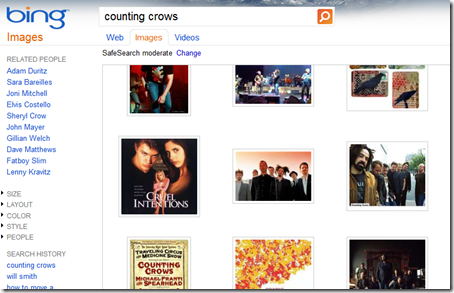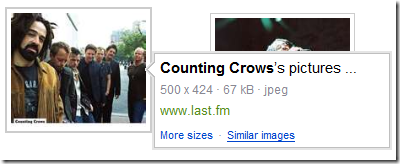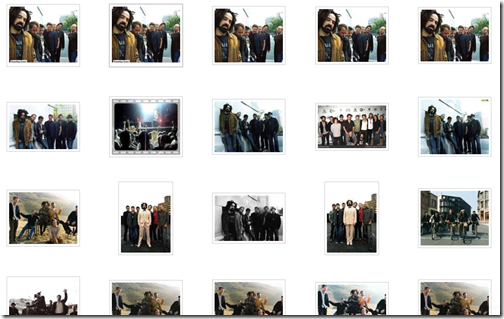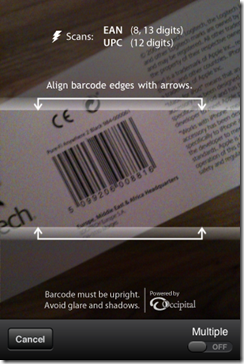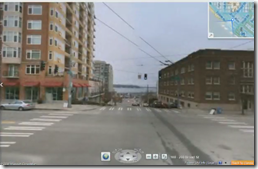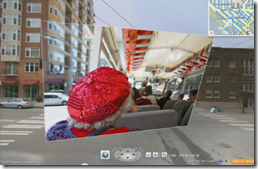How to find things online without searching (Part 3 of 5)
 This mini series of posts focuses on methods of finding information online without typing a single search phrases in to Bing, Google or any other search engine. Part 1 focussed on check in services and part 2 discussed social voting mechanisms.
This mini series of posts focuses on methods of finding information online without typing a single search phrases in to Bing, Google or any other search engine. Part 1 focussed on check in services and part 2 discussed social voting mechanisms.
In this post I will highlight search technologies which allow people to search the web using photographs and other visuals…
Image search without keywords
This post series is all about how to find information on the web without typing search words, so I would be cheating if I discussed traditional image search (such as the awesome functionality provided by Bing).
However, one particular piece of technology which can be found in Bing image search does warrant inclusion in this blog post – that of ‘Similar images’, which utilises image recognition technology to find images which are similar to those you have selected. So looking at these image search results for ‘Counting Crows’…
I can see a cool looking photo of the band casually standing around, which I would like to find similar images to…
With one click on ‘similar images’ Bing will intelligently match similar photos (but not necessarily the same) and present a page full of casual looking photos…
Neither Bing or Google let you search using the image as a starting point (yet), however https://www.tineye.com does let you upload a photo, or provide a URL to a photo on the web and then search for similar photos – no search words required! This is a great way to search the web for sites who have used your photographs/diagrams without asking for permission ![]()
Facial search – fantastic or scary?
![image[24] image[24]](https://msdntnarchive.blob.core.windows.net/media/MSDNBlogsFS/prod.evol.blogs.msdn.com/CommunityServer.Blogs.Components.WeblogFiles/00/00/01/28/40/metablogapi/4807.image24_thumb_286C8097.png) As image/facial recognition advances on the web, the power of image search becomes more and more exciting! (or perhaps worrying). Face.com is a great example of facial recognition working well to automatically scan your facebook photo albums, and those of your friends and automatically tag you and your friends in the photos.
As image/facial recognition advances on the web, the power of image search becomes more and more exciting! (or perhaps worrying). Face.com is a great example of facial recognition working well to automatically scan your facebook photo albums, and those of your friends and automatically tag you and your friends in the photos.
If you haven’t yet tried it, I guarantee you will be impressed with the accuracy!
Philanderers, weekend drunks and secrets agents…beware! Whilst you may be efficient at untagging yourself from embarrassing Facebook photos and checking for undesirable mentions of your name within search results, it’s only a matter of time before every single photo/video of you will be discoverable with a couple of clicks – whether you are tagged in them or not. In fact, I think the technology is already there – perhaps there are privacy issues preventing such a service…I will read more about it when I get the chance.
Barcode scanners
 A few weeks ago I was shopping in a local electronics retailer for some travel speakers. After being pestered by the shop assistant who was trying to demo and sell me the set of speakers which would get him most commission, I finally made up my mind and asked him to go and fetch a Logitech speakers for me which were priced at £105.
A few weeks ago I was shopping in a local electronics retailer for some travel speakers. After being pestered by the shop assistant who was trying to demo and sell me the set of speakers which would get him most commission, I finally made up my mind and asked him to go and fetch a Logitech speakers for me which were priced at £105.
When he proudly walked back with the package, I pointed my iPhone at the side of the box and ‘scanned’ it using the RedLaser app. This app uses image analysis to detect bar codes using the iPhone camera, and then automatically searches for products online which match the scanned barcode…
As you can see, the product was available much cheaper than £105 online. I show the shop assistant the screen of my phone, which prompted him to “go speak to his manager” and resulted in a discounted price of £80 for the speakers ![]() The ‘search’ took just 3 or 4 seconds and I didn’t have to type a single search word.
The ‘search’ took just 3 or 4 seconds and I didn’t have to type a single search word.
By the way, this functionality is also available free of charge in the latest Bing iPhone app, however unfortunately that app is not officially launched in the UK (where I am based).
Connecting the pieces together
Of course, recognising a barcode, converting it to a product code and then searching for that product code online is not making use of image search functionality, but instead just relatively simple image recognition followed by a keyword search.
Google Goggles is a first effort to connect the pieces together in a way which allows users to search the web by simply pointing their phone’s camera at an image. This video explains how Google Goggles send images from the phone, runs them through image search processors online and then returns relevant web results…
Using Google Goggles still requires the user to make a ‘search’, even if they do not need to type a keyword. As we move towards the future, we will see technology simply present images, related facts or other pieces of contextual information to users at the point of need. Bing.com maps provides a great example of seamlessly ‘searching’ for and blending Flickr photos on top of street side imagery, using advanced image recognition and manipulation to present contextually relevant and valuable information without the user having to even think about the word ‘search’…
Finally check out this video demo of Bing.com maps and take a few moments to imagine the possibilities of these types of contextually aware, automatic, unobtrusive visual searches which enhance any browsing experience by providing easy and instant access to any relevant data on the web…
Author: Chris Moore is a program manager from Microsoft working on Search Engine Optimisation. Follow him on Twitter
